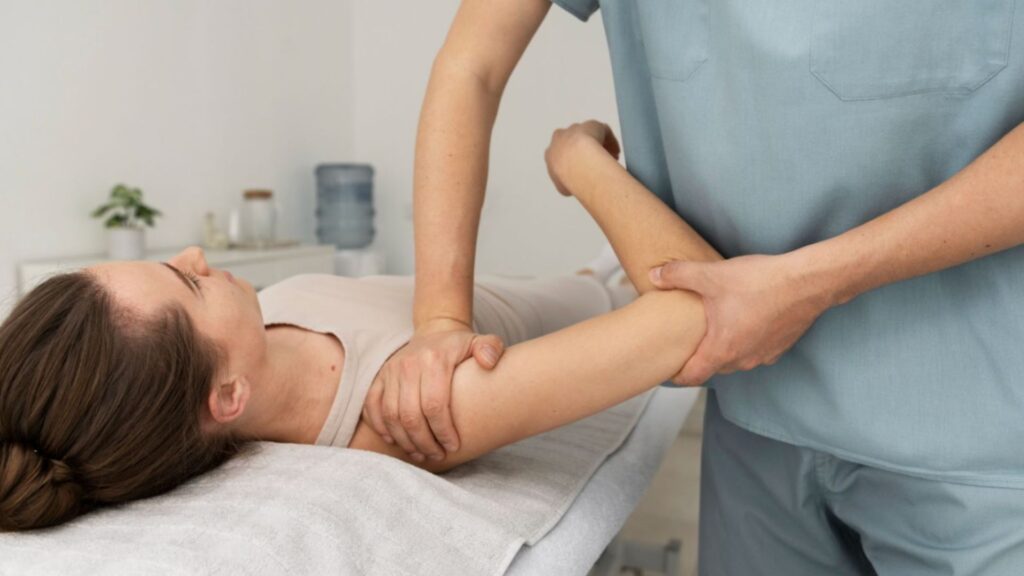Manual Therapy
Manual therapy is the foundation of any physiotherapy practice. It provides a hands-on method of treating musculoskeletal problems and enhancing general wellness. In this post, our physical therapist experts will delve into manual therapy, exploring its definition, benefits, associated techniques, and suitability for different individuals. Whether you’re seeking relief from pain, improved mobility, or enhanced performance, understanding manual therapy can assist you in making informed decisions about your healthcare journey.

Are you experiencing pain due to a medical condition, surgery, or injury? Manual therapy could be a great way to address your issues. Manual therapy can aid healing and enhance your general function if you have been injured and are experiencing problems. Our physical therapists at Motion Physical Therapy employ various tools and techniques to reduce pain and enhance function. Contact us to schedule an appointment and get started!
Manual Therapy Techniques
Here are some of the different manual therapy techniques:
Joint Mobilization
A manual therapy approach called joint mobilization involves the therapist applying pressure to a joint by hand to increase its range of motion and mobility. It is used to treat joint discomfort or stiffness. For instance, joint mobilization may treat a patient with tendinitis in the shoulder or golfer’s elbow.
Soft Tissue Mobilization
The therapist manually stretches and presses on the muscles and ligaments using a manual technique called soft tissue mobilization. This technique helps ease stress and lower inflammation by breaking up the muscle tissue. Additionally, it can increase flexibility to such an extent that it’s frequently utilized to restore lost joint mobility.
Strain-Counterstrain Therapy
Positional release therapy, also known as strain-counterstrain therapy, is a form of manual therapy in which the therapist places your body in a sequence of prearranged positions for 90-second bursts. It is advantageous because it enables the body to rest in a way that is not usually possible for the muscle’s sensory receptors but is both comfortable and natural. It’s a mild yet efficient method of releasing muscle tension.

Myofascial Release
A manual treatment approach called myofascial release therapy focuses on the fascia, the thick tissue covering all of our muscles and bones. To restore flexibility, the physical therapist feels around the fascia for tight or stiff areas and manipulates them manually. Pressure is released from the joints and muscles by using this technique. The process is iterated on every trigger point until the therapist can detect any residual tension in the body. It is used to treat chronic pain conditions like sciatica and back pain.
Instrument-assisted Soft Tissue Mobilization (IASTM)
A manual therapy approach called instrument-assisted soft tissue mobilization (IASTM) uses tools or instruments to mobilize the joints and muscles. These instruments differ in size and form, but they are shaped to fit different body areas, giving the physical therapist more control over how much pressure they may put on the patient.
Dry Needling
Thin needles placed into the skin are used in the physical therapy technique known as “dry needling” to release trigger points, which are inflexible muscle fiber areas. The objectives include releasing tense muscles, reducing discomfort, improving blood flow, and regaining mobility. Although dry needling sounds similar to acupuncture, it is not the same. At the same time, acupuncture seeks to interrupt pain pathways; dry needling targets the muscles currently in pain. Like other manual therapy approaches, it works best when incorporated into a more comprehensive treatment plan that includes therapeutic exercise and other forms of care.

Active Release Techniques (ART)
Some physical therapy clinics (including some Alliance sites) use a branded, proprietary manual therapy technique called Active Release Techniques (ART). In an ART treatment, the therapist applies intense pressure to soft tissue that has experienced recurrent acute injuries or repetitive strain injuries that have changed its size or structure. The patient is instructed to move in ways that will stretch the soft tissue simultaneously. It is used to address a wide range of chronic pain conditions.
The Benefits of Manual Therapy
Here are the benefits of manual therapy:
Pain Relief
Manual therapy techniques, including joint mobility and soft tissue manipulation, can help lessen pain by relieving tension, enhancing circulation, and encouraging relaxation in affected areas.
Enhanced Mobility
Manual therapy can improve the range of motion and functional movement patterns by addressing joint mobility and muscle flexibility limits. It can help people carry out daily activities more efficiently.
Quicker Recovery
By encouraging the body’s natural processes for tissue regeneration and repair, manual therapy speeds up the healing process and shortens the recovery period following surgeries or accidents.
Enhanced Performance
Through focused interventions, manual therapy helps athletes and active people achieve their best physical performance, avoid injuries, and reach their full athletic potential.
Holistic Approach
Rather than merely treating the symptoms of musculoskeletal dysfunction, manual therapy treats the underlying cause of the condition, offering a holistic approach to healing.
Frequently Asked Questions
What is Manual Therapy?
Manual therapy encompasses a variety of specialized techniques that your licensed physical therapist will use to identify and treat musculoskeletal issues. In contrast to conventional medicine, which uses drugs or surgery, manual therapy strongly emphasizes the expert application of manual techniques for joint manipulation and soft tissue mobilization to relieve pain and restore correct function.
Is Manual Therapy Right For Me?
Manual therapy is suitable for individuals of all ages and activity levels who suffer from musculoskeletal pain, stiffness, or dysfunction can benefit from manual therapy. Manual therapy can be customized to meet your unique requirements and goals, whether you’re managing chronic pain, recovering from an injury, or want to improve your physical well-being. To guarantee safe and efficient treatment outcomes, your physiotherapist at Motion Physical Therapy will perform a comprehensive assessment to identify the best manual therapy technique for your ailment.
What Will My Treatment Look Like?
Your treatment will depend on the result of a thorough examination, which will be conducted by your physiotherapist as the first step in your manual therapy treatment to determine the underlying reasons for your problems and create a customized treatment plan that meets your specific requirements. Your treatment plan may include therapeutic exercises, manual therapy techniques, and information on self-management practices to help you heal as quickly as possible and avoid getting hurt again. Your physiotherapist will carefully monitor your progress during each treatment session, make any necessary adjustments to your treatment plan, and provide the tools you need to be actively involved in your recovery.
Is Manual Therapy Safe?
Yes. Manual therapy is a safe, therapeutic approach for treating people in pain from illness or injury. Physical therapists use manual therapy to release soft tissue and stiff joints. This state-of-the-art therapeutic technique helps with joint mobilization, mobility enhancement, edema reduction, and restraint.
Does This Treatment Method Hurt?
No, this treatment does not hurt. Receiving manual therapy is not meant to make your discomfort worse. The importance of manual therapy for pain relief is substantial. Many people who are new to physical therapy anticipate that their sessions will hurt, hurt, or perhaps hurt unbearably. Manual treatment, on the other hand, is painless and noninvasive. The best part is that it also functions well without the requirement for prescription drugs that could be harmful.
Manual Therapy at Motion Physical Therapy
Manual therapy is a very effective method for managing musculoskeletal pain and dysfunction, offering several advantages, including pain reduction, increased mobility, and improved performance. People can take proactive measures to achieve optimal physical well-being and make educated decisions about their healthcare by being aware of manipulative physiotherapy concepts, techniques, and applicability. You may move better, feel better, and live a better life with the help of manual therapy at Motion Physical Therapy, whether you’re recuperating from an injury, taking care of a chronic disease, or just trying to live life to the fullest. Schedule a same-day appointment now!
Motion Physical Therapy
127 Queen Anne Rd, Bogota, NJ 07603, United States
(201) 331-8330
Our Services
- Orthopedic RehabilitationOrthopedic Rehabilitation
- Post-Surgical RehabilitationPost-Surgical Rehabilitation
- Sports Injury RehabilitationSports Injury Rehabilitation
- Geriatric RehabilitationGeriatric Rehabilitation
- Injury PreventionInjury Prevention
- Therapeutic ExerciseTherapeutic Exercise
- Manual TherapyManual Therapy
- Telehealth ServicesTelehealth Services
- Postural AssessmentPostural Assessment
- Balance RehabilitationBalance Rehabilitation

